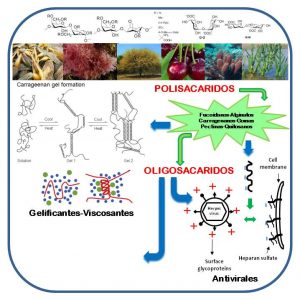Polisacáridos complejos
Grupo de trabajo.
Carlos A. Stortz – Profesor Titular DE FCEN/UBA – Investigador Superior CONICET
Diego A. Navarro – Profesor Adjunto DS FCEN/UBA– Investigador Adjunto CONICET
Nora M. A. Ponce – Jefa de Trabajos Prácticos DE FCEN/UBA – Investigadora Adjunta CONICET
Yasmín Daglio – Jefa de Trabajos Prácticos DS Agro/UBA– Becaria Postdoctoral CONICET
Frank Sznaider – Ayudante de Primera DE FCEN/UBA
Tomás Benech Arnold – Ayudante UGS – Becario Doctoral Conicet
Romina Cingolani – Becaria Doctoral Conicet
Matías Villarreal – Tesista
Resumen
Los principales objetivos del grupo son aislar, purificar, estudiar estructuralmente y modificar polisacáridos obtenidos de diversas fuentes (algas, frutos, invertebrados). El estudio se direcciona especialmente a la detección de productos con actividad biológica (antiviral, antitumoral, antioxidante), propiedades funcionales de interés para la industria o con estructuras novedosas de interés académico. Además, se establece la necesidad de conocer la composición y estructura de las paredes celulares de frutos y relacionar los cambios operados en la pared celular en distintos estados de madurez y como consecuencia de distintas fisiopatías o procesos de almacenamiento que muchas veces llevan a pérdidas económicas. Se hace especial hincapié en la modificación quimica de oligo- o polisacáridos aislados de fuentes naturales, con caracterización previa con el objetivo de mejorar sus actividades biológicas y sus propiedades reológicas. También se intenta poder correlacionar los datos estructurales obtenidos con los que se obtengan a partir del análisis de actividad biológica, propiedades físicas, etc., y del análisis conformacional por modelado molecular, ya que la conformación de un polisacárido es uno de los factores determinantes de sus propiedades. Es de nuestro interés extrapolar los modelos de di- y trisacáridos sulfatados provenientes de carragenanos y fucoidanos a formas polisacarídicas, y determinar finalmente las claves de su actividad biológica. También se modela la reactividad de algunos carbohidratos. Se está poniendo especial énfasis en el mejoramiento de la metodología experimental y computacional existente.
Abstract
The main purpose of our group is to isolate, purify, study structurally and modify chemically polysaccharides retrieved from different sources (seaweeds, fruit, invertebrates). The study aims especially to the detection of products with biological activities (antiviral, antitumor, antioxidant), functional properties for industrial applications, or novel structures of academical interest. Besides, we are assessing the composition and structure of fruit cell walls in different ontogenic stages, and as a consequence of different physiopathies or extended storage, which may lead to economical losses. The group emphasizes the study of the chemical modification of oligo- or polysaccharides isolated from natural resources, previously characterized, with the purpose of improving their biological activities and rheological properties. We are also trying to establish a correlation between the structural data obtained experimentally from chemical studies with those obtained from the analysis of biological activity, physical properties, etc., and from conformational analysis obtained by molecular modeling simulations, taking into account that the conformation of a polysaccharide is a key factor of its properties. We are interested in extrapolating the models of sulfated di- and trisaccharides from carrageenans and fucoidans to larger, polysaccharidic models, and to determine finally the clues of their biological activities. Emphasis will also be given to the improvement of experimental and computational methodologies.
Publicaciones seleccionadas / Selected publications
Monthly fluctuations in the content and monosaccharide composition of fucoidan from Undaria pinnatifida sporophylls from Northern Patagonia. M. Arijon, N. M. A. Ponce, V. Solana, F. G. Dellatorre, E. A. Latour, C. A. Stortz. Journal of Applied Phycology, 2021, en prensa. DOI: 10.1007/s10811-021-02465-5
Perennial halophyte Salicornia neei Lag.: Cell wall composition and functional properties of its biopolymers. M. R. Villarreal, D. A. Navarro, N. M. A. Ponce, A. M. Rojas, C. A. Stortz. Food Chemistry 350, 128659 (2021)
Chemical structure and rheological studies of arabinoglucoxylans from the Cercidium praecox exudates brea gum. F. Sznaider, A. M. Rojas, C. A. Stortz, D. A. Navarro. Carbohydrate Polymers 228, 115388 (2020)
A comprehensive and comparative analysis of the fucoidan compositional data across the Phaeophyceae. N. M. A. Ponce, C. A. Stortz. Frontiers in Plant Science 11, 556312 (2020)
Disaccharides obtained from carrageenans as potential antitumor agents. G. H. Calvo, V. A. Cosenza, D. A. Sáenz, D. A. Navarro, C. A. Stortz, M. A. Céspedes, L. A. Mamone, A. G. Casas, G. M. Di Venosa. Scientific Reports 9, 6654 (2019)
Fucoidans from the Phaeophyta Scytosiphon lomentaria: Chemical analysis and antiviral activity of the galactofucan component. N. M. A. Ponce, M. L. Flores, C. A. Pujol, M. B. Becerra, D. A. Navarro, O. Córdoba, E. B. Damonte, C. A. Stortz. Carbohydrate Research 478, 18–24 (2019)
Minor polysaccharidic constituents from the red seaweed Hypnea musciformis. Appearance of a novel branched uronic acid. V. A. Cosenza, D. A. Navarro, C. A. Stortz. Carbohydrate Polymers 157, 156–166 (2017)
Partial and total C-6 oxidation of gelling carrageenans. Modulation of the antiviral activity with the anionic character. V. A. Cosenza, D. A. Navarro, C. A. Pujol, E. B. Damonte, C. A. Stortz. Carbohydrate Polymers 128, 199–206 (2015)